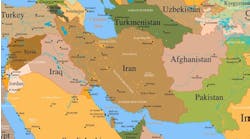Over the next five years, Infield Systems expects 224 fields to enter production offshore West Africa. In the last five years, 63 fields came onstream. Nigeria leads this trend, with new field developments increasing from 21 (2008-2012) to 84 going forward to 2017. Looking at reserve additions (MMbboe), Infield Systems expects the largest proportionate growth to take place outside the traditionally dominant areas of Angola and Nigeria; particularly offshore Cameroon, Congo (Brazzaville), Equatorial Guinea, and Ghana. Key fields include Tullow's TEN fields and the Total-operated Moho Nord Marine. The Ivory Coast enters the forecast with the development of nine fields over the 2013-2017 timeframe. The largest is expected to be the Gazelle field, anticipated to be brought onstream in 2014 by Rialto Energy Ltd. Across the region, Infield Systems expects deepwater reserves to comprise 60% of total additions from 2013-2017. This is a slight decrease on the deepwater additions from 2008-2012, primarily due to a number of shallow-water gas fields, led by Nigerian developments, such as the Shell-operated HB project and Addax Petroleum's Udele West. Both are expected to come onstream during the period. At the same time, Infield Systems expects significant growth in the ultra-deepwater market, increasing from 5% to 16% of total reserve additions. Key ultra-deepwater fields expected to enter production in the next five years include: Egina at a water depth of 1,550 m (5,085 ft) offshore Nigeria, and Cameia at a depth of 1,682 m (5,518 ft) offshore Angola. In terms of operators, Total is expected to remain dominant, but Infield Systems also expects West African offshore development to remain robust for Shell, Chevron, and ExxonMobil.
– Catarina Podevyn, Analyst, Infield Systems Ltd.






